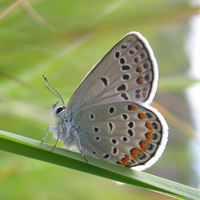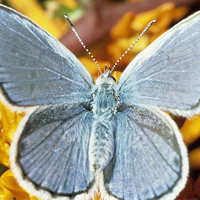Karner Blue
Scientific name: Plebejus samuelis


Cover photos credit: Brenda Kulon (left) and Jeffrey S. Pippen (right)
Status
Extirpated
Extirpated
means the species lives somewhere in the world, and at one time lived in the wild in Ontario, but no longer lives in the wild in Ontario.
Date added to the Species at Risk in Ontario list
The Karner Blue was listed as endangered when the Endangered Species Act took effect in 2008. On February 18, 2009 the Karner Blue was re-assessed as extirpated.
Read the most recent assessment report (PDF)
On January 26, 2022, the scientific name of this species was updated on the Species at Risk in Ontario list from Lycaeides Melissa Samuelis to Plebejus samuelis to follow the naming used by NatureServe. This name change does not change the protections afforded to the species under the Endangered Species Act, 2007 (ESA) or the applicability of any policies, permits and agreements, guidance documents or best management practices that may have been published or issued by the Government of Ontario in respect of the species.
What it looks like
The male Karner Blue is a small butterfly with a wingspan of 2.5 centimetres, or about the size of a quarter. Its deep blue wings have black edges and a white outer fringe. Females are similar but are a darker, purple-blue to purple-brown in colour, with a row of dark spots with orange crescents along the wing edges. The undersides of both the male and female wings are light silver- grey with black dots and orange crescents along the outer edges. The larva of the species is covered in very fine hairs and for protection from predators, it matches the color of the green leaves of the plants it lives on.
The female Karner Blue lays eggs on or near wild lupine, the sole food source of the larvae. Two butterfly broods are produced each year. In spring, eggs that were laid the previous year metamorphose to produce a first brood of caterpillars. These caterpillars pupate and adult butterflies emerge in May. These adults then mate and lay eggs in June. After a week, the eggs hatch and the resulting caterpillars feed for three weeks before pupating into adult butterflies in late summer. Adult butterflies that emerge in late summer mate and lay eggs that do not hatch until the following spring.
Where it lives
The habitat of the Karner Blue is restricted to where wild lupine grows – in sandy soils, sandy pine barrens, beach dunes, and oak savannahs.
Where it’s been found in Ontario
The most recent occurrences of Karner Blue were recorded in southwestern Ontario at Port Franks and St. Williams in the late 1980s. However, evidence suggests that Karner Blue was historically more widespread with records from Toronto, London and Sarnia.
The Karner Blue occurred in isolated populations from New Hampshire and New York, west through southern Ontario and states bordering the Great Lakes to Minnesota. The Karner Blue is extirpated from some of the states throughout its range, but some jurisdictions (for example, Ohio and New Hampshire) have initiated reintroductions.
Why it disappeared from Ontario
Habitat loss is responsible for the decline of the Karner Blue throughout its range. Much of Ontario’s original savannah and barren habitat have been destroyed by development or taken over, through natural succession, by plants that create shady conditions. These conditions are unsuitable for the growth of wild lupine which requires open, sunny areas. Suppression of wild fires that once kept areas open and free of shade-producing shrubs and trees is another factor contributing to the loss of this increasingly rare habitat.
Action we are taking
Karner Blue receives species protection under the Endangered Species Act, 2007.
Help make sure we don’t lose more endangered species in Ontario
Report a sighting
Report a sighting of an endangered animal or plant to the Natural Heritage Information Centre. Photographs with specific locations or mapping coordinates are always helpful.
Volunteer
Volunteer with a local nature club or provincial park to participate in surveys or stewardship work focused on species at risk.
Be a good steward
Private land owners have an important role to play in species recovery; you may be eligible for stewardship programs that support the protection and recovery of species at risk and their habitats.
Report illegal activity
Report any illegal activity related to species at risk to
Quick facts
- In 1944, novelist Vladimir Nabokov first identified the Karner Blue butterfly, which takes its name from the hamlet of Karner in New York state.
- The Karner Blue has a lifespan of about five days as an adult butterfly.
- Karner Blue caterpillars feed exclusively on the leaves of the wild lupine; the adult butterfly does not depend on lupine exclusively and feeds on a variety of flowering plants.
- Karner Blue caterpillars have a mutually advantageous relationship with mound-building ants, which protect the caterpillars from predators like spiders and parasites; in exchange, the caterpillars excrete a sugary substance which is consumed by the ants.
- Declines in wild lupine populations and savannah and barren ecosystems are also responsible for the extirpation of two other butterfly species in Ontario, the Frosted Elfin and Eastern Persius Duskywing.